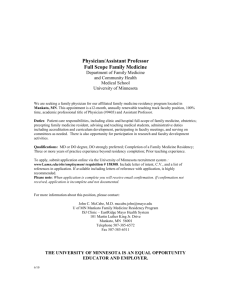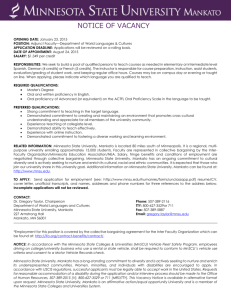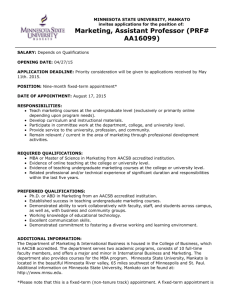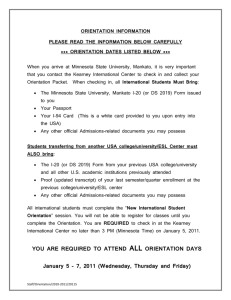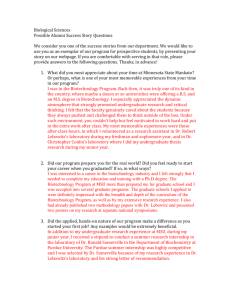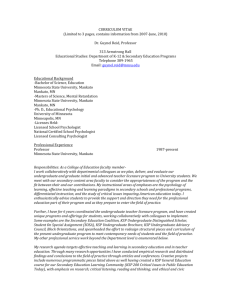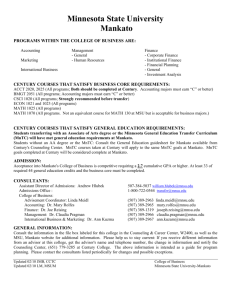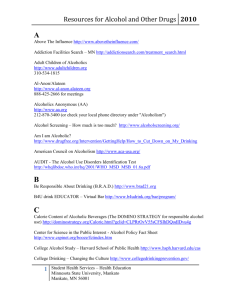Rural-urban conflict and farmer-labor politics : Blue
advertisement
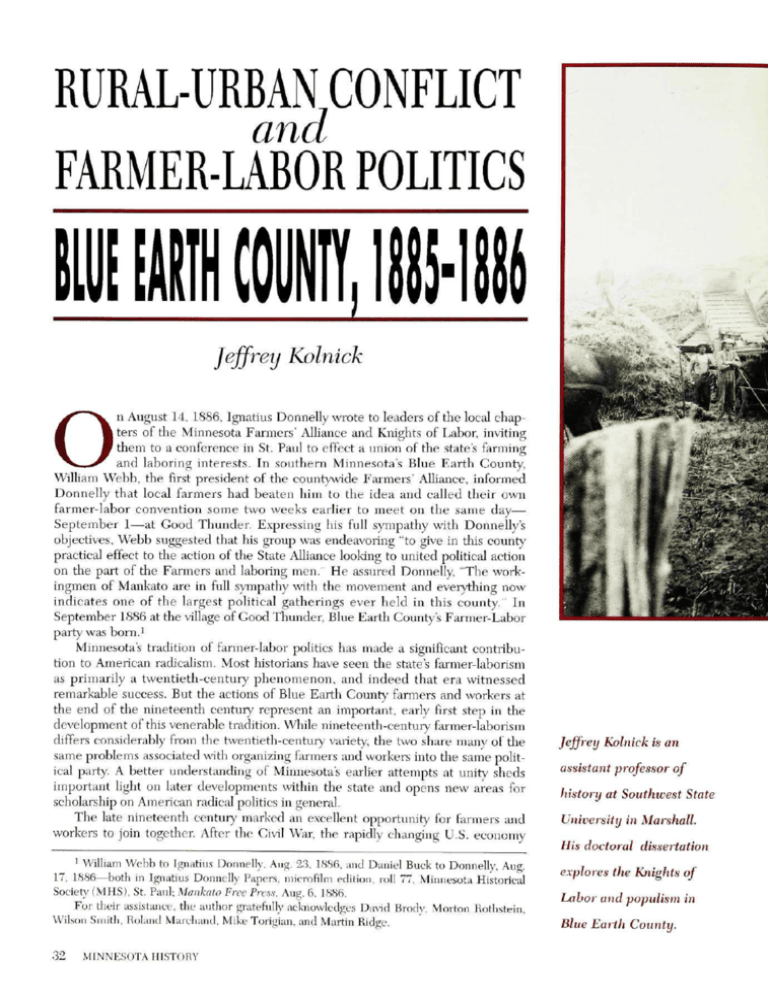
RURAL-URBANCONFLICT and FARMER-LABOR POLITICS Jejfrey Kolnick O n August 14, 1886, Ignatius Donnelly wrote to leaders of the local chapters of the Minnesota Farmers' Alhance and Knights of Labor inviting them to a conference in St. Paul to effect a union of the state's farming and laboring interests. In southern Minnesota's Blue Earth County, WilHam Webb, the first president of the countyvride Fanners' Alliance, informed Donnelly that local farmers had beaten him to the idea and called their own farmer-labor convention some two weeks earlier to meet on the same day— September I—at Good Thunder Expressing his full sympathy with Donnelly's objectives, Webb suggested that his group was endeavoring "to give in diis county practical effect to the action of the State Alliance looking to united political action on the part of the Farmers and laboring men. He assured Donnelly, "The vvorkingmen of Mankato are in full sympathy with the movement and everything now indicates one of the largest political gatherings ever held in this county. In September 1886 at the village of Good Thunder Blue Earth County's Farmer-Labor party was born.i Minnesota's tradition of farmer-labor politics has made a significant contribution to American radicalism. Most historians have seen the state's farmer-laborism as primarily a twentieth-century phenomenon, and indeed that era witnessed remarkable success. But the actions of Blue Earth Count)' farmers and workers at the end of the nineteenth century represent an important, early first step in die development of this venerable tradition. While nineteenth-centur)/ farmer-laborism differs considerably from the twentieth-century variety, the two share many of the same problems associated with organizing farmers and workers into the same political party. A better understanding of Minnesota's earlier attempts at unity sheds important light on later developments within die state and opens new areas for scholarship on American radical pohtics in general. The late nineteenth century marked an excellent opportunity for farmers and workers to join together After the Civil War the rapiclly changing U.S. economy Jeffrey Kolnick is an assistant professor of history at Southwest State Universittj in Marshall. His doctoral I William Webb to Ignatius Donnelly, Aug. 23, 1886, and Daniel Buck to Donnell)', Aug. 17, 1886—both in Ignatius Donnelly Papers, microfilm edition, roll 77, Minnesota Historical Society (MHS), St, Paul; Mankato Fr-ee Press. Aug. 6, 1886, For their assistance, the author gratefully acknowledges David Brody, Morton Rothstein, Wilson Smith, Roland Marchand, Mike Torigian, and Martin Ridge, 32 MINNESOTA HISTORY dissertation explores the Knights of Labor and populism in Blue Earth County. Thi-eshingcr-ew pausing for photographer, 2 On late-nineteentli-centurv worker and farmer ideologv', here and two paragraphs below, see Bnice Palmer, "Man Over Money ': The Southern Populist Critique of American Capitalism (Chapel Hill: University of North Carolina Press, 1980); Robert C. McMath, Jr., Amer-ican Populism: A Sociid Histon), 1877-1898 (New York: Hill and Wang, 1992); Michael F. Magliari, "California Populism, A Case Study: The Farmers' Alliance and People's Party in San Luis Obispo County, 188.5-1903" (Ph.D. diss., University of Cahfornia, Davis, 1992); Nick Salvatore, Eugene V. Debs: Citizen and Socialist (Urbana: University of Illinois Press, 1982); Leon Fink, Workingrnen's Democracy: The Knights of Labor and American Politics (Urbana: University of Illinois Press, 1983); Lawrence Goodwyn, Democratic Pr-omise. The Populist Moment in America (New York: Oxford University Press, 1976); and Thomas A, Woods, Knights of the Plow: Oliver H. Kellctj and the Origins of the Grange in Republican Ideology (Ames: Iowa State Universit)' Press, 1991). Blue Earth County, about 1890 created opportunities for some but hardship for manv. The rise of a world market in agricultural commodities led to an overall decline in the prices of staple crops. T h i s d e v e l o p m e n t c o i n c i d e d w i t h t b e c r e a t i o n of uncompetitive systems for marketing these c o m m o d i ties. The farmers of the West and South reacted to these changes bv forming such organizations as the Patrons of Husbandry (Grange) and the Farmers Alliance to help them s u n i v e on the land. Animated bv powerful producer and antimonopolv traditions, farmers t u r n e d to politics and cooperatives to solve their economic problems. By 1890 the countn'side was ablaze with radical fanners. 2 Wliile farmers struggled to come to grips with the changing economv', workers organized in the cities and towns across America. As manufacturing jobs b e c a m e concentrated in fewer and fewer large firms, the old traSPRING 1994 33 ditions of artisan production were fast becoming antiquated. The general deflation of the post-Civil War period drove real wages down, and in periods of depression, survival itself became an issue for many workingclass families. Workers responded to those conditions by striking, creating and joining national unions, and turning out to vote. At least until 1890 the most powerful force for reform among workers was the Knights of Labor, a national union founded in 1869 to eliminate the wage system dirough the use of cooperatives, education, and the ballot. Among farmers, the Alliance stood poised to reform society. In Minnesota both of these organizations began to flex their political muscles in earnest in 1886. Within this context farmer-labor politics became a possibility. The spread of industrial and finance capitalism clashed with the Knights' and Alliancemen's understanding of what America should be. These groups held that industriahzation threatened to transfer real power in society from small, economically independent producers into the hands of greedy plutocrats. Far removed from the production of any useful good, these business leaders seemed to exercise extraordinary power in ruthless ways. Most people who joined the Knights and the Alliance beheved that society was best sewed when all heads of households worked for themselves, doing an honest day's labor While few Americans of this era had any quarrel with competitive capitalism, almost all agreed that monopolies were an evil to be combated. The goal of the Knights of Labor and the Farmers' Alliance was to reclaim America from the monopohsts and return it to the actual producers of wealth. In Blue Earth County, these two organizations joined together to accomplish that end. Studying the ideas and actions of farmers and workers at the grass roots sheds light on the nature of farmer-laborism. When Blue Earth County citizens organized their own Farmer-Labor party in 1886, purely local concerns simultaneously attracted and repelled the rural and urban elements of that coalition. In the end, their shared experiences in trying to understand the rise of monopoly capitalism and changes in market relations led to a common vision. Combined with the influence of powerful national, state, and local movements, this vision helped farmers and workers overcome deeply entrenched prejudices and local divisions, if only for a brief period of time. B lue Earth County seemed an unlikely place to spawm such a coalition. In 1885, one year before the organization of the local Farmer-Labor party, the county was torn by a fierce rural-urban conflict over a local tax measure. That episode began on March 24, 1884, on die banks of the Minnesota River in the county's principal city, Mankato. Stephen Lamm, a prominent local businessman just returned from a trip through southeast Minnesota, addressed the Mankato Board of Trade on the need for a new county courthouse. Lamm argued that the current facihty appeared shabby and gave strangers the impression that Blue Earth County was either behind the times or lacking in enterprise. His pitch to the board met an enthusiastic response, and his motion that the group bring this pressing matter to the county commissioners was unanimously approved. The commissioners, likewise, gave complete support to the proposal. A new courthouse in Mankato seemed inevitable for the progressive citizens of Blue Earth County. At the behest of the Board of Trade, the state legislature passed an act on Februar)' 10, 1885, allowing the county commissioners to issue $75,000 worth of bonds to build die courthouse, subject to ratification by tbe voters of the county. The election was set for May 5.3 The citizens of Mankato rejoiced at this news. A city of some 7,800 people in 1885, Mankato ranked sixth among the urban centers of Minnesota. It was known around the country for its superb hmestone and cement, and the count)' commissioners assured citizens that local labor would build the courthouse using local materials. 3 Thomas Hughes, History of Blue Earth County (1909; reprint, Chicago: Middle West Pubhshing Co., 1977), 199. .34 MINNESOTA HISTORY Mankato, about 1880. fron^ a .stereograph by local photographer The Standard Cement Company of Mankato illustrated die pubhc spirit of area businesses by offering to supply all the cement needed for construction at "actual cost. "^ The city's people were clearly bullish on the bond measure. To the workers it meant jobs; to the business community it meant contracts. To all it would provide a grand edifice symbolizing the progressive and enterprising character of Mankato. So convinced were the cit)''s voters about the benefits of the new building that in May they approved the bond measure by a vote of 1,461 to 2, with all but 100 eligible voters going to the polls.'' Voters in the rural districts of Blue Earth County opposed the bonds with almost equal fervor By the •1 The Review (Mankato), July 7, 1885; Mankato Free Pr-ess, May 1, 1885, •5 The Review, May 11, 1885; Mankato Fr-ee Press. May 8, 1885. ^ Mankato Free Press, Apr. 17, 1885; The Revieic. May 5, 1885. For farmers' opposition to taxes and its influence on populism, see John D. Hicks, The Populist Revolt: A Histonj of the Fanners Alliance and the People's Party (Lincoln; University of Nebraska Press, 1961), 86; Stanley B. Parsons, The Populi.st Context: Rural Versus Urban Poiver on a Great Plains Fr-ontier (Westport, Conn.: Greenwood Press, 1973). E. F. Everitt middle of April, country people were making their views public. One resident of Shelbv Township, writing under the pseudonym "farmer " responded to a Mankato Free Press article that claimed the c u r r e n t facilities w e r e "unsightly" and "disgraceful in appearance" bv arguing: "Though the present structures, with their modest proportions may distress the cit)' gazer the farmer who visits them occasionally, to pay his tax, is not humiliated to any extent by their appearance. The farmers of the count)' are certainly not rich," he continued. "Thev hve for the most part in unsightly' dwellings, and the only buildings that shelter their animals are veiT "unsightlv" straw stables. He saw tbe May 5 vote as the farmers' opportunity "to show their appreciation of Mankato's past liberality in count)' matters. We tnist thev will do so by voting solid against t h e b o n d s . " M e m b e r s of t h e Pleasant VIound Grange echoed these antiurban sentiments. They also felt that the election date "justlv lays the commissioners open to the charge of conniving to d e f e a t t h e will of t h e p e o p l e , " since f a r m e r s w e r e unusually busy at that time. Tbe Grangers urged all who opposed this "extravagance and ring mie' to go to the polls and defeat the measure. And they did.^ On May 5 they voted 1,905 to 338 against the bonds, thus defeating the measure countvwide bv 108 votes. SPRING 1994 35 not democratically accept bonded indebtedness, they would have no choice but to pay for the building in property taxes year after year At the annual township meetings in March 1886, rural voters voiced their disapproval. Shelby Township resolved: The alacrity with which the said commissioners have proceeded to ignore the verdict and sacrifice the interests of their own constituents, the rural voters, at the instigation of the defeated city minority, and the flippancy with which they . discussed the matter ought to distinguish men in responsible positions [as] being too weak to resist city dictation or too stupid to comprehend the magnitude of their offense against the whole rural population.^ Blue Earth County's amtested courthouse; 1905 photograph by Albert Munson The principal support for the courthouse in the rural areas came from a few towmships adjacent to Mankato. The people of Shelby Township showed their disapproval by polling 20 more residents in this special election than they did in the 1884 presidential race, casting 151 votes against the bonds and only 7 in favor" By the middle of 1885, Blue Earth County was divided along rural-urban lines. A. M. Kilgore of Mankato explained to the farmers that "the pa)mient of two-thirds of a cent per acre in taxes would have given employment to more than 100 men in furnishing materials and in work on the building. Similarly disappointed, the editor of the Mankato Free Press claimed, "The farmers of the county generally have got a wrong idea of the kind of men Mankato is made of For years they have been paying out money that goes strictly for the benefit of the county, without protest, and we may say without thanks." The people of Mankato—workers and businessmen—felt betrayed by the rural districts. Soon after the defeat of the bonds, the Board of Trade and the county commissioners reorganized their efforts. Arguing that they were bound by law to provide the county with "suitable" buildings, the commissioners in July 1885 levied a property tax on all county residents to raise $18,000 for the new courthouse. In early January 1886, architects were invited to submit plans and specifications. The commissioners appointed a building committee, and its chairman was authorized to advertise for bids to grade the courthouse lot. As local historian Thomas Hughes later wrote: "While no formal resolution to that effect was passed, the commissioners had unanimous!)' come to the conclusion, to begin the erection of a new Court House "'^ If the people would .36 MINNESOTA HI.STORY The people of Vernon Center Township resolved that the commissioners' use of taxation should be characterized as a usurpation of rights "without precedent, as entirely without authority of law or sanction of the courts, and as tyrannical and despotic in its nature and inconsistent with principles of all constitutional government and destructive of the rights of free people." At least five other townships voiced similar concerns. Despite these protests, the courthouse was built. Rather than submit to a direct tax year after year Blue Earth County citizens approved $30,000 worth of bonds in March 1887—by a slim majority of 73. Voter turnout was light in Mankato, only 803, "the general feeling being that if the country people did not want the building finished at once, Mankato people would not insist." The citizens of Blue Earth County ended up paying slightly more than $123,000 for the edifice, which was finished by October 1, 1889, but not dedicated untd 1989, the centennial year when tempers had sufficiently cooled off To this day, the count)''s literature reminds citizens that the courthouse belongs to everyone, not just the people of Mankato.i" W hile rural-urban conflict raged in Blue Earth County, the United States was engaged in a bitter dispute over the role labor would play in the new industrial order The Great Upheaval of 188.5-1886, a period of major labor unrest, provided the political milieu within which farmers and workers could form a political party, despite local tensions. '• Here and below, see The Review. Ma)' 11, 1885; Mankato Fr-ec Pr-css. Mav 8, 1885. For a similar niral-urban conflict, see James B. Potts, "Farmers and Townsmen: The Popocrats of Otoe Countv-, Nebraska, 1890-1896," unpubUshed paper, copy in author's possession. « Hughes, Blue Earth County, 200-201. 9 Here and below, see The Rcviciv. Mar. 16, 1886. 10 Mankato Free Press, Mar. 11, 1887; Elizabeth Barta, ed.. Blue Earth County (n.p., 1984), 4. T h e Knights of Labor c r e a t e d real excitement in 1885 w h e n they twice brought financier and railroad baron Jay Gould to the bargaining table. Historian Selig Perlman relates the significance of this act: " H e r e a labor organization for the first time dealt on an equal footing with probably the most powerful capitalist in the country. The oppressed laboring masses finally chscovered a powerful champion. All the pent-up feeling of bitterness and resentment . now found vent in a rush to organize under the banner of the powerful Knights of Labor"ii And organize they did. Membership in the Knights skyrocketed from 110,000 in July 1885 to more than 700,000 a year later The level of labor agitation in these two years was u n p r e c e d e n t e d in t h e history of t h e industrial world; m o r e t h a n 2,000 strikes o c c u r r e d involving more than 500,000 workers. T h e perceived power of the Knights of Labor indicated to many that the time was ripe for the p r o d u c i n g classes to seize 11 Selig Perlman, A Histor-y of Tr-ade Unionism in the United States (New York: MacmOlan, 1922), 87-88. On the Great Upheaval, see Jeremy Breclier, Strike! (Boston: South End Press, 1977), 25-50; Norman J. Ware, The Labor Movement in the United States, 1860-1895: A Study in Democracy (New Y'ork: Vintage Books, 1964); Philip S. Foner, Histonj of the Labor Movement in the United States (New York: International Publishers, 1955), 2:50-55, 8.3-88, 98-114; Fink, Workingrnen's Democracy. See also Ruth A. Allen, The Great Southioest Strike, University of Texas Publications, no. 4214 (Austin, 1942). 12 Bruce Laurie, Ar-tisans into Workers: Labor in Nincteenth-Centunj America (New York: Noonday Press, 1989), 156; David Montgomery, Workers Control in America: Studies in the Histor-y of Work, Technology, and Labor Struggles (Cambridge: Cambridge Universitv Press, 1979), 20; The Review, Mar. .30, 1886. 13 Mankato Free Press, Apr. 2, 1886; The Review. Mar, 30, 1886; Record of Proceedings of the Twentieth Regular Meeting of D.A. [District Assembly] 79, Knights of Labor (Minneapolis: Thomas A, Clark & Co,, 1887), 15, in John P. McGaughey Papers, MHS. i"! Here and below, social structure compiled from U. S., Manuscript Census, 1880, Population, Blue Earth County, microfilm edition, roll 615, and Minnesota, Manuscript Census, 1885, Population, Blue Earth Count)', roll 21—both MHS. On ethnicity in nineteentli-centurv' voting, see Paul Kleppner, The Cross of Culture: A Social Analysis of Midwestern Politics, 1850-1900 (New York: Free Press, 1970). Still, most historians have found that support for the producer movement cut across ethnic lines; see Magliari, "California Populism," 16-18, On town development and class relations somewhat like Mankato's, see Shelton Stromquist, A Generation of Boomers: The Pattern of Railroad Labor Conflict in Nineteenth-Century America (Urbana: University of Illinois Press, 1987); Michael H. Frisch, Town ir-ito City: Springfield. Massachusetts, and the Meaning of Community, 1840-1880 (Cambridge: Haivard Universitv Press, 1972); Salvatore, Eugene Debs. p o w e r The climax of the Great Upheaval came in May 1886 with the eight-hour strikes, die Haymarket Affair, and l a t e r with a series of losing strikes all over t h e nation. During this period Blue Earth County e.xperie n c e d t h r e e strikes of skilled and unskilled workers. Strikes were so pen'asive that John C. Wise, editor of M a n k a t o ' s n e w s p a p e r . The Review, q u i p p e d w h i l e reporting on one at a q u a n y in nearby Kasota that they seemed "contagious."12 It was in this atmosphere of widespread excitement that an enthusiastic crowd of worldngmen packed the Mankato city hall on Saturday, March 27, 1886, to hear Knights of Labor organizer C. A. Lincoln. At this meeting, and again on Monday, Lincoln told his listeners that they must organize to defend their rights, through politics and in t h e workplace. H e p r o c e e d e d to c h a r t e r Local Assembly 7925 of Mankato, with a membership of about 150, and place in n o m i n a t i o n a workingmen's municipal ticket for the cit)' elections in April. vUthough the new Workingmen's party won no seats, it polled a remarkably large vote, considering it had but one week to organize and campaign.i3 Why did the workers of Mankato hurry to organize their owm paiiy when a year earher the courthouse vote s h o w e d b u s i n e s s a n d l a b o r in h a r m o n y ? W h i l e Mankato's rapid commercial development during t h e 1880s generally benefited residents, it also created tensions among them. The cit)' consisted of approximately one-third white-collar and two-thirds blue-collar workers (see page 38). Most of those who wore white collars engaged in sales, although professionals also made up a sizable portion of their ranks. Among blue-collar workers, the skilled slightly outnumbered the unskilled, and the building trades represented the largest percentage. Nativity seems to have played an insignificant role in d e t e r m i n i n g blue-collar occupations b u t significantly affected access to white-collar jobs: A higher percentage of native-bom people went to work in white shirts.n Mankato's neighborhoods reflected diese class and status differences. The first ward represented the most distinctive enclave, largelv composed of foreign-bom workers who voted Democratic. T h e second and third wards, located in tbe center of town, t e n d e d to have fewer immigrant residents, almost always backed the Republican part)', and bv 1885 represented a haven for white-collar types. The fourth ward became more working class during the first five years of the 1880s and was nearly split between ioreign-born and native-born residents. Neither paitv could count on the fourth ward at election time. In all, late nineteentb-centuiy Mankato did not resemble the one-industry towns or industrial cities studied so thoroughly bv labor historians. A competitive political system e m e r g e d in Mankato, d u e in large part to diis mix of foreign- and native-born voters. Neither workers nor businessmen could e.xpect to dominate at either the ballot box or die workplace. SPRING 1994 3^^ l[iOS!liOOKnUID'SfOi The 1885 Minnesota manuscript census shows 2,170 men at least 21 years old living in Mankato's four wards. Cit)' directories listed occupations for 1,287—some 60 percent. Another 5 percent were listed without occupations; presumably, they were eidier retired, disabled, or still living at home (only the father's occupation was given in this case). VOTING-AGE MEN IN MANKATO, 1885 # Ward 1 % Ward 2 # Ward 3 % Ward 4 # % # Totals % Census count 645 100 498 100 ,395 100 635 100 2,170 100 Fully listed in city directoiy .361 56 268 54 250 63 408 64 1,287 59 No occupation in city directory Not hsted in city directory 32 249 23 39 207 20 42 Several factors may explain why about 35 percent of the voting-age men counted in the census were not listed in the city directories. Many of the "missing persons" lived in boardinghouses or hotels and were usually not recorded. (Mankato's first and second wards contained all of the city's hotels, which helps explain the high percentages of men not listed from those neighborhoods.) In addition, young sons of working fathers do not appear with any regu- 125 26 32 201 32 101 5 782 36 larity. Finally, it is Kkely that about half of the missing people were die celebrated "floating proletariat," laborers who were in town at die time of the census but soon moved on. Although they swelled the ranks of blue-collar workers to approximately two-thirds of Mankato's population, they probably did not participate in local politics. The following chart accounts for the 1,287 Mankato men of voting age for whom occupations are listed in the city directories. OCCUPATIONAL CATEGORY OF VOTING-AGE MEN IN MANKATO, 1885 Ward 1 Ward 2 # # Ward 4 % Totals # % Blue collar 273 43 1.32 26 120 30 226 36 751 35 White collar 73 133 3 126 32 168 23 1 3 1 14 26 2 500 15 11 2 26 Farmer 36 2 D i f f e r e n c e s over h o w M a n k a t o s h o u l d d e v e l o p clearly emerged during the years of the Great Upheaval. In the closing days of 1884, tbe founding of the city's Workingmen's Association foreshadowed the divisions separating workers from their employers. M e m b e r s called for legislation that would lead to workmen's compensation for injuries caused by "the carelessness of a f o r e m a n " a n d a m e c h a n i c s l i e n law for w o r k e r s e m p l o y e d on p u b l i c p r o j e c t s . T h e y also b e g a n disc u s s i n g a r t i c l e s from a s e m i m o n t h l y p a p e r , t h e Workingmen's Friend. These actions reveal that workers 38 Ward 3 % MINNESOTA HISTORY had gained a sense of their interests as distinct from those of their employers.'''' P erhaps the best way to explain the growing intrau r b a n tensions is to examine t h e b a t t l e waged between Mankato workers and m e m b e r s of the middle class over the right to run cows t h r o u g h t h e streets to undeveloped, privately held land on the outl'5 Mankato Free Press. Dec. 12, 1884; The Review, Jan. 20, 1885 '>--.U.i;&,'-A^?«^. . Mankato workers, about 1881, at an urban shop ivith mral skirts of towm. Having cows in the city was not being questioned; at issue was the right to use another person's land as free pasture. With free pasture a cow might profit a working-class owner handsomely; without it, cow ownership b e c a m e a break-even venture at best, with profit or loss depending on the cost of hay. At stake in this conflict were questions about the m e a n i n g of property rights, tbe nature of class relations during the Gilded Age, and the relationship of urban p e o p l e to agrarianism. IS Here and below, for the best discussion of the stock-law controversy, see Steven Hahn, The Roots of Southern Populism: Yeoman Farmers and the Transformation of the Georgia Upcountry, 1850M890 (New York: O.xford University Press, 1983); Robert C. McMath, Jr., "Sandy Lands and Hogs in the Timber: (Agri)cultural Origins of the Farmers' Alliance in Texas," in Steven Hahn and Jonathan Prude, ed.. The Countryside in the Age of Capitalist Trcmsfor-rnation: Essays in the Social Histonj of Rural America (Chapel Hill: Universit)' of North Carohna Press, 1985), 205-29. See also, McMath, American Populism, 54-56; Fred A. Shannon, The Farmers' Last Frontier: Agi-iculture, 1860-1897 (New York: Farrar & Rinehart, 1945), 218 (quote); Allan G, Bogue, Fi-om Prairie to Corn Belt: Farming on the Illinois and Iowa Pr-airies in the Nineteenth Centunj (Chicago: Quadrangle Books, 1968), 73-83, business T h e t r a d i t i o n of " c o m m o n l a n d s ' in t h e U n i t e d States extends back to the colonial era. U n i m p r o v e d farm land was left unfenced, a source of free firewood and pasturage. Rich and p o o r tenant and farm owner, and in some cases even slaves bad access to these lands. The high cost of fencing virtually prohibited die enclosure of all the acreage held by a farmer and the face-toface r e l a t i o n s h i p s of rural c o m m u n i t i e s m a d e easv access to unused lands seem natural.i^ F e n c i n g c o m m o n l a n d s c r e a t e d social c o n f l i c t throughout the countryside during the lS70s and IS80s, in p a r t fueling t h e a g r a r i a n revolt of t h e F a r m e r s ' Alliance a n d p o p u l i s m . T h e a d v e n t of i n e x p e n s i v e b a r b e d wire m a d e it feasible to enclose lands. S o m e people j u m p e d at the opportunity, others resisted the change, and fierce political battles raged in tbe countryside over stock laws. Supporters on the northern plains posted signs on their fences to discourage grazing on their newly enclosed lands. O n e example read; " T h e Son of a Bitch who opens this fence had better look out for his scalp." Grazing livestock on common lands was not an issue strictly for farmers. T h r o u g h o u t tbe earlv n i n e t e e n t h centur)', animals roamed the streets of American cities. Maintaining cows or pigs provided an important source SPRING 1994 :39 of real income for workers. For example, until the 1840s iron workers in western Pennsylvania often expected their employers to provide a barn and pasturage for a cow. As industrial capitalism developed, workers often lost this traditional source of income. This loss led to an increasing dependence on the market for wages and threatened the goal of economic independence. The issue of common rights to pasture linked industrial workers to poor farmers during the Gilded Age.i'^ In Blue Earth County, workers and businessmen in the city and farmers in the countryside struggled over this issue. Beginning in the 1870s the rural townships voted on whether to fence unused lands, and by 1886 the last one had voted to "restrain beasts." Mankato contended over the cow, with changes of policy, until 1896 when the animals were forever banned from walking the streets. In 1880 the Mankato Free Press complained that "the running at large of horses and cattle in this city is an annoyance to the public which is intolerable" and a hazard to property and health. These arguments were repeated again and again by middle-class elements in Mankato who linked the development and good image of the city to abandoning archaic customs like the running of stock on city streets.i'^ At the bottom of this long-smoldering issue was debate over using vacant lots as pasture. Even if the land were owned by someone, workers, unlike some property owners, felt that it should be free for all to use. To hold such land in the city and deny neighbors access to it was tantamount to monopoly. And in this case, the monopoly would cut deep into the pocketbooks of working-class families and further their dependence on the wage system. As Alderman Nic Peterson stated in an 1891 city council debate, 'In many cases the word cow 1'^ William A. Sullivan, The Industrial Worker in Pennsylvania, 1800-1840 (New York: Johnson Reprint Corp., 1972), 59. For battles over working-class husbandly into the 1870s, see Herbert G. Gutman, Power h- Culture: Essays on the American Wor-king Class, ed. Ira Berlin (New York: Pantheon Books, 1987), 201-202. 1^ Mankato Free Press. May 20, 1880, June 26, 1885. The health issue concerned horses, not cows. Runaway horses posed a danger to pedestrians. Cows watering at Minnehaha Creek and Eighth Avenue South, Minneapolis, about 1900 40 MINNESOTA HISTORY for some "enterprising capitalist" to build more housing, means half a living to a man, and if the proposed ordithe Free Press reported in July 1885, "In most places, nance passed, those having pasture would monopolize it the price of rents has declined, while the reverse is the and charge poor men a high rent for it."'^ fact here."21 To cope with the increased cost of housing, One example of just how deep that cut would be workers clung to their traditional sources of income. was reported to The Review in 1881. W H. Allen The profits from keeping a cow could easily cover four claimed his family realized a profit of $12.28 from a cow that his wife convinced him to purchase seven months months' rent. earher (This amount remained after deducting the cost By early July 1885, however businessmen were so of feed and the purchase concerned with the "cow price of the animal.) For question" that 137 of the entire year the Aliens them petitioned tbe city could expect to net $20.00; council to prevent tbe aiiithe next year, with their iiials from roaming the cow paid for, their profit city streets. In response, might increase to $60.00. two counteiqietitions were Likewise, in 1886 M. W. submitted, signed by 263 Mendenhall claimed that friends of the cow. Rather his hvo cows "yielded him than risk compromising $105.00 in ten and a half their political futures, months, besides affording Mankato's aldermen aba family of four with cream stained from settling the and milk." In 1885 the issue; instead, they decidMankato city assessor reed to submit it to the votported 846 cattle, 195 Widell's stone cpiarry, Mankato, from Frank Leslie's ers in the 1886 election. sheep, and 213 hogs.20 Illustrated Newspaper, 1891 Perhaps the officials As Mankato boomed, r e m e m b e r e d the town these resources became meeting at which fights more important. Between 1880 and 1885 the population broke out over the question, a melee that resulted in the of Mankato grew by 41 percent, from 5,550 to 7,838 arrest and fining of some of Mankato's leading citizens.22 people. This growth resulted in higher wages, more building, and more jobs, but it also brought higher rents ther business-labor issues were also and a housing shortage. In January 1883 The Review in Mankato at this same time. In 1885, two had commented, "There is a growing demand for small quany strikes rocked the towm. Earlv in Mav, tenement houses by the laboring classes who have 40 men at the Empire Quart)' of W B. Craig struck over found work in the city, and die question is, if the supply wages and the time of their payments. Craig resolved is Umited now, what will it be next Spring and Summer the strike by filling the quarry "widi new men." Then on when the extra hundreds of men will be engaged in our June 2, about 150 men at three quarries struck for a stone quarries and other industries." In August 1883 the 25c-a-day raise. The strike began at Ring and Fowler's Free Press answered that question: "The buildings in the quarry and was soon joined bv die men at McMullen's. city are all crowded, many harboring two or more famiBy this time the strikers numbered 110, and thev Hes, who are compelled to live in a crowded condition." marched to Saulpaugh's quarrv, where the owner George Clark, a local real estate dealer estimated that a reportedly took the tools of the workers and "made single-family home would rent from $10.00 to $15.00 them promise not to go to work tomorrow." The per month. Despite constant urging by the local papers Minneapolis Tribune put this situation in perspective when it reported: "There are over 600 men employed in the quarries . . . [and] it is ven' easy to see that a univerIS Mankato Free Press, June 23, 1891. sal disaffection among them would lead to trouble of no 20 The Review, Aug. 9, 1881; Mankato Free Press. Apr. 2, small proportions." The St. Paid Globe ended its storv 1886; Blue Earth County Assessor, Assessment Rolls, Cit)' of on tlie first day of the strike bv reporting, "The police Mankato, 1885, Minnesota State Archives, MHS. are called upon to be present at 8 A.M. to-morrow. 21 The Review, Jan. 16, 1883; Mankato Free Press. Aug. 3, Trouble is anticipated." In the end, the owners claimed 1883, July 3, 17, 1885. that diey could not afford the demanded raise and dis22 The Review, June 23, July 7, 1885. charged about 25 of "the turbulent ones"; the remaining 2''5 St. Paul Pioneer Press, May 5, June 3, 5, 1885; St. Paul strikers returned to work at tbe old rate.2'3 Daily Globe, May 5, June 3, 1885; Minneapolis Tribune, June 4, 6, 1885; The Review, June 9, 1885; Mankato Free Press, June 5, A year later on June 24, 1886, a large number of 1885. laborers hired to lay tracks for a street railway struck for o SPRING 1994 41 a 25c-a-day raise, which would have increased their daily pay to $1.50, the average for a Mankato laborer Tbe contractors refused to grant the raise and suggested that those workers who did not want work at $1.25 per day "could look elsewhere for a job."2-i The strikes, the courthouse controversy, and the dispute over running cows in Mankato during the Great Upheaval illustrate the complexity of economic growth in small towns during the Gilded Age. Workers were willing to stand shoulder to shoulder with the local business elite to create jobs, like building the courthouse. But they differed with their bosses over bow to allocate the profits that development brought and what purposes it should serve. Workers were not prepared to accept middle-class plans for development if it meant complete dependence on wages by ending free pasturage for urban cows. These tensions came to a head in the municipal election of April 1886. The Workingmen's paity shared the ballot with the Democrats and the Republicans and polled a substantial portion of the city's working class, garnering most of its support in tlie first and fourth wards. Mankato voters also decided the cow question that day. The vote was close; 671 to 611 favored maintaining the current "wide-open policy." The strength of this support followed exactly the strength of the Workingmen's party: The first and fourth wards cast large majorities in favor of the cow, while the second and third wards, where white-collar workers and businessmen set the political tone, overwhelmingly opposed the urban bovine.2'5 T he workers of Mankato had asserted themselves politically by forming tbe Workingmen's party and sustaining the right to run cows through the city. They seemed certain to e.xercise some strength in the November elections. This development was welcomed by the Blue Earth County Farmers' Alliance, which in August 1886 called for a "mass convention of farmers and laboring men" to meet at Good Thunder on September 1 and nominate a slate of candidates for county office.26 In so doing, the Farmers' Alhance openly courted the very workers its members had opposed on the courthouse issue a year earher The history of farmer movements in Blue Earth County suggests a tendency toward farmer-labor cooperation. The Farmers' Alliance had come to Blue Earth County in 1881 and grew rapidly. A year later H local chapters met in Mankato to nominate a slate of candidates for office. Also present at the convention were representatives of the Pleasant Mound Grange, four towns, and the city of Mankato, whose delegation was headed by F. B. Bonsall, later a member of the Workingmen's Association executive committee. The convention adopted a platform that called for the restoration of "equal rights to all" by restraining "giant 42 MINNESOTA HLSTORY monopolies and railroad companies [that] have conspired together to defraud the people of their rights and liberties. "2" Of particular concern to the Alliance in 1882 was the railroad-and-wheat combination. In December I88I representatives of the railroads, wheat buyers, and millers met in Minneapohs to "devise some means so as to get a uniform grade and a fair price." They established standard tests for grades and agreed upon prices. They also called for a committee with the power to designate the prices paid at every railroad station in the state. In effect, they sought to eliminate competitive bidding on wheat among the largest buyers in Minnesota, "practically plac[ing] the wheat market in the power of two or three men," according to The Review. The newspaper's editor concluded, "Such a combination is so repugnant to eveiy instinct, impulse, and principle of a free people, that it will not be quietly submitted to."2s The farmers did not submit quietly. In Februar)' 1882 a call went out for the nine separate Blue Earth County alliances to form a countywide group. If the wheat men were determined to speak with one voice, then so too were the farmers. In its first set of demands the county Alliance d e n o u n c e d the railroads of Minnesota for their "system of rebates and discriminations . whereby independent buyers are driven from the market" and demanded that the legislature pass "a stringent law" compelhng railroads to grant equal access to all buyers and sellers. The Alliance also opposed the wheat combination and strongly urged that "action cannot too soon be taken to control by law the inspection of wheat."29 In their earliest struggles against monopoly. Blue Earth County Alliaiicemen were mindful that, while they represented the farmers of the county, "the evils" of which they complained were "general in nature." Therefore, they invited help from "all who believe with us that the encroachments and exactions of corporate power is such a menace to free government as to demand the most positive and vigorous action on the part of all patriotic people." On April 15, 1882, the group resolved that "die war which the farmers of this county are waging against monopoly and oppression is one in which the laborer the mechanic, the aitisan, the merchant and the professionable [sic] man are equally interested with ourselves, and that in our opinion, they should be invited to work in die same ranks as us."'^o Of 2-1 Mankato Fr-ee Press. June 25, 1886. 2-5 The Review, Apr. 13, 1886. 26 Mankato Free Press. Aug. 6, 1886. -'' The Review, Sept. 26, 1882. 2« The Review. Dec. 20, 1881. 29 The Review, Feb. 28, Mar. 14, 1882. •™ The Review, Miu. 14, Apr. 25, 1882. course, this position only opened the door to debate about how nonfarming comrades would be included. A chance to test members' commitment to principle came shortly thereafter In late August 1882, Alhance leaders met to discuss the practical issues associated with caOing their nominating convention in September The Alliancemen had to decide whether to include delegates from Mankato. J. McGiven favored "putting a ticket in the field by the farmers, believing that those who sympathized with the order would give it their hearty support." But J. G. Thompson objected, fearing this plan would ""antagonize" voters in Mankato, who, after all, held one-third of the county's votes.^i At this point, Lysander Cook, one of the most respected men in the county, argued that if the principles of the Alliance were to succeed, "we must open our doors." He suggested that there were "merchants, business men, and mechanics whose sympathies are with us." The Review reported, "He would almost say that the alhance movement did not deserve to succeed if we ignore this element." Cook reminded his brothers that when he was elected to the state legislature by the Granger movement, an open convention was called and "the people did attend and took part in a mass convention." He then "ridiculed" the idea that the only "manipulating politicians' were in the city and moved that a committee be appointed to make the call for the convention. The committee proposed, and the meeting adopted, a call for an open convention with each organized alliance and "each town or ward in this county who are in sympathy with the Alliance movement" getting three delegates apiece. Thus, Blue Earth Count)' farmers had established a tradition of rural-urban harmony that dated back to the 1870s and was reinforced with the birth of the countywide Farmers' Alliance in 1882. This tradition was based on firm support for producer values, a staunch commitment to antimonopoly legislation, and the shared experience of struggle with the new economic order At the local level, the Knights of Labor and the Farmers' Alliance existed as neighbors. Still, members of the different organizations might have seen their struggles as separate fights against different enemies. And the ongoing feud between city and country over the courthouse might have bhnded the neighbors to the larger causes that bound them. As it turned out, though, local capitalists came to the aid of the emerging farmerlabor coalition by bringing the monopoly issue home to both city and country dwellers. •^1 Here and below, see The Review, Sept. 5, 1882. •^' 2 The Review, Mar. 9, 1886. For an insider's account, see Vernard E. Lundin, The Hubbard Milling Company. 1878-1978: A Past to Remember—A Future to Build (Minneapohs: T. S. Denison & Co., 1978); incorporation, see 31-32. Mankato merchant and store, displaying bags of locally milled Hubbard flour, about 1881 I n early March 1886 The Review complained about the emergence of a wheat monopoly organized by tbe Hubbard mill at Mankato. R. D. Hubbard & Co., or the "Big Mill" as it was known locally, incoi"porated in 1878 at a value of $80,000 and managed to exercise considerable control over the Mankato wheat market. It was one of 15 signatories to the 1881 agreement among the millers, wheat buyers, and railroads. The Review quoted at length a report by the state railroad commissioners on the wheat market in Vlankato which claimed, "There seems to be three buyers [of wheat], but there was in fact but one, for Hubbard & Co. dictated prices, grades and dockage, and got tbe wheat." Local farmers agreed that the "Mankato wheat market is as represented in the report." There was a general sentiment to boycott tlie Mankato market when practical and to build a cooperative farmers' warehouse outside tbe citii'.''2 The Review debated this matter with George M. Palmer Hubbard's secretarv-treasurer Palmer wrote forcefully that the mill paid all it "could afford"; anyone who beheved be could make money pa)iiig more was welcome to trv. Palmer claimed that the rather stick"v SPRING 1994 43 R. D. HUBBAED. F.. L. WATTiBS. D. HUBBARD & CO., IMERCHANT MILLERS, MAKnrACTURKIt& O F — — Choicest Roller Flours—-Superlative and Mankato Brands. BeauretOKet It, ondaHBrOTie triBlTou wlllun. n^ioiber. It will malid RETTBR BREAD. WAITER BUKAD, CHBAPBR DREAD Bed mor.. or u tbaD ftny olbsr. Directions Cor Maklnir Hreart. .«I'','V.t ^."""^ " ' ' " " * ' " ^ " ^ ^ *^'^ *'"''"^'^"''*'«*'^'"'''^l o'y<*«l "*•* loo'W ^t"* thlolcnoBi of haiuir. BnaioiiinsuoTernlglili thonadd floar pnouBli tokuMdioniv (wcDIy mlnnto*. oruntliu will not cling to lliobo«rt.ajItr,.]olf«imu..limori.knc»dliiB thM Wlowr Wbi.at Flour. L..I It rlie In ibo pan. then mnko mtopmallloBTM, and l«t It ilBBBKBln. Uake In a modorstooven. Bo enre and not let II aland lo Uis oven Biter It la done, and we will promise jou a inoet heautirul, sweet, white brvad. llirectlims for Making: the Bfst Yoa*t. Doll B handful of hoiis In two qoorts of woter ton liilnolos. Then strain, and to tbe ll.i.ior add six (ioo4 el^cdBrBtod potBiooB. onecnpof soger andoiielahlBsiwooafaalt. Lot It almtner ono-half hour, wbeo lukew»mt. add one cup of good yeast, ond lot It rise. Koop In a cvered Jar In • cool place. ( ^ ^ t a r m c r s E-xchaDgfj on tbo moat ll!icr.al tt)rnip.-.©a Advertisement from The Review,/w/y 14, 1885, promising fanners "the most liber-al terms" prices paid by the various buyers s t e m m e d from the information Hubbard & Co. provided off its wire to the different railroad stations and markets along tbe line. In response. The Review, an ardent defender of free competition, called for an independent buyer to enter the Mankato wheat market. '"When one man or a firm is vested with [monopoly] power, they are not e.xpected . that they will pay as high prices as when there is free, open and honorable competition." The blame for this sad state of affairs rested with the "business men of Mankato." The Review suggested that these entrepreneurs combine to put a buyer on the market who would "pay an advance over what is now paid." It was not too late for those businessmen with a sense of fair play and civic pride to rescue Blue Earth County from its homegrown monopoly. ••'•^ Little seems to have come of this suggestion, and the county's farmers c o n t i n u e d organizing to get for themselves what the business elite of the citv' failed to provide. But as the s u m m e r of 1886 approached, the H u b b a r d mill began to exercise extraordinary power over the city's flour market. The Review, which had kept a watchful eye on the company, discovered an attempt 44 MINNESOTA HISTORY by t h e m i l l , in c o m b i n a t i o n w i t h t h e G r o c e r s ' Association, to exclude all other brands of flour from Mankato. Ultimately the goal was for local retailers to sell only Hubbard flour in return for a commission from the mill. The plan failed when three or four merchants refused to participate. The Review made the connection that, had the scheme succeeded, the grocers and mill would have estabhshed a 'monopoly whereby the price of flour could be advanced at the whim of one individual just as the price of wheat is now controlled."'^ The specter of a local monopoly incurred the wrath of urban and rural people and provided fertile soil in which to sow the seeds of farmer-laborism. Thus the call for t h e farmer-labor c o n v e n t i o n to b e h e l d in Blue Earth County on September 1, 1886, found eager part i c i p a n t s . M o v e d b y t h e e v e n t s of t h e i r t i m e s a n d e n c o u r a g e d by t h e s t a t e l e a d e r s h i p of M i n n e s o t a ' s F a n n e r s ' Alliance and Knights of L a b o r some 500 farmers and workers crowded into the meeting hall at Good T h u n d e r to found t h e F a r m e r - L a b o r p a r t y of Blue Earth Count)'. The assembled delegates, most of them members of the Knights and the Alliance, endorsed a declaration of principles that called for a g r a d u a t e d income tax, abohtion of child and convict labor, recognition of unions, new and better laws regulating railroads and grain elevators, condemnation of the organization of grain dealers, forfeiture of all u n e a r n e d railroad land grants, the reservation of public lands for actual settlers, and abrogation of those laws that favored monopoly over the interests of the common good.'^'^ The air was thick with the radical rhetoric of producerism and antimonopoly, language familiar to both fanners and workers within the reform tradition. Tbe delegates d e n o u n c e d "the rapid accumulation of the wealth of the country in the hands of a comparatively few men" who used their power to "corrupt or intimidate the people in the exercise of their pohtical rights." So serious was this problem that, in an age of unpreced e n t e d political partisanship, the convention rebuked the "old parties' and felt it "necessary for the people to organize in their own defense." Just before the unanimous ratification of their platform, one farmer referred to the impending farmer-labor alliance as a "wedding. F o r a brief m o m e n t , t h e p r o d u c i n g classes of Blue Earth County overcame d e e p divisions in an attempt to seize p o w e r from the monopolists and t h e i r c o r r u p t pohticians. The convention went on to nominate candidates for t h e N o v e m b e r election. To gain t h e b a c k i n g of t h e Farmer-Labor part\', candidates pledged to support the resolutions passed that day C o u n t y Republicans and '» The Review. Mar. 16. 2.3, 1886. ^* The Review, Sept. 28, 1886. 3'5 Here and below, see The Revieiv, Sept. 7, 1886. Democrats met after the farmer-labor convention and endorsed many of the Good Thunder contenders. In November, Farmer-Labor candidates captured three out of four county seats in the state legislature and secured the election of the county treasurer auditor clerk of the court, probate judge, coroner and superintendent of public schools. Generally, though, only diose endorsed by a major party won. The Farmer-Labor party could count on only about 600 straight votes; approximately 2,600 votes were needed for election to countywide office.36 T he success of Blue Earth County's Farmer-Labor party in rallying voters and in influencing the major parties was remarkable, especially given the rural-urban conflict that rocked the county from 1885 to 1887. To account for this, we must first remember that party members were also members of the Knights of Labor and Farmers' Alliance. Without these groups organized at the grass-roots level, a successful coahtion would not have been possible. Their common agenda, based on their common struggle with the new industrial society, was a second major factor in the party's success. Finally, the Great Upheaval created the conditions that allowed local people to transcend their differences and unite around larger issues. Two additional points are pertinent here. First, the statewide organizations of the Knights and the Alliance encouraged the formation of local farmer-labor parties. 'V\'hen William Webb of the Blue Earth Counts' Alliance wrote Ignatius Donnelly to express his regrets regarding his absence at the state conference, he suggested an exchange of greetings by telegraph on the day of the conventions. Donnelly agreed, and when Webb informed the St. Paul conference of Blue Earth County's demand for independent political action, Donnelly wired back the support and good wishes of the state organizations.•3''' Webb's experience with issues above the county level gave him a broader pohtical perspective. Tbe union of farmer and labor leaders at the state level helped convince those at the local level that they too could find common ground. Second, the statewide organizations encouraged local coalitions at just the right moment. While the people of Blue Earth County remained largely untouched by the events of the Great Upheaval, these labor con- '36 The Review, Sept. 7, Nov. 9, 1886. On third-party politics during the Gilded Age, see Jeffrey Ostler, Pr-airie Populism: The Fate of Agrarian Radicalism in Kansas, Nebraska, and Iowa, 1880-1892 (Lawrence; University Press of Kansjis, 199.3). 37 Webb to Donnelly, Aug. 23, 1886; unidentified St. Paul newspaper clipping, Sept. 4, 1886, in Scrapbook, McGaughey Papers, MHS. '38 The Review. Sept. 7, 1886. frontations across the countr)' indicated that, if they failed to act at this crucial time, their fate might be decided by the likes of a Jay Gould or a James J. HiU. Until the Good T h u n d e r convention. Blue Earth County's participation was limited to three unsuccessful strikes and the fielding of the Workingmen's municipal ticket in April 1886. Tbe formation of the Farmer-Labor party represented greater willingness to take part in the Great Upheaval. Even while being forged, however the coalition was tenuous. As the Good Thunder convention came to a close, L. F. McKibben of the Pleasant Mound Grange offered resolutions claiming that "the influence of city pohticians has too long been dominant in the affairs of the count)'" as evidenced in the "most extravagant and offensive form, of the defeated courthouse measure, which is now being carried out by illegal taxation." His resolutions were adopted "by a decisive vote." (The rural districts could ouh'ote the cit)' at the convention, 94 to 20.) The reemergence of the courthouse controversy at this gathering reveals that the marriage between rural and urban producers would require much counseling. The same issue of The Review that reported on the convention also printed a statement by "the executive committee of the labor organizations of Mankato, which made clear that members "do most emphatically oppose so much of the resolutions passed at the Good Thunder convention, opposing the completion of the court-house, are not in favor of abandoning the work [and] as a body opposed it at the convention, and will not by any means be bound by it."3'^ Despite last-minute convention bickering, however, tbe Alliance-Knight coahtion of 1886 succeeded. In 1890 and again in 1892, farmer-labor politics reemerged in Blue Earth County. In the twentieth centur}', the Minnesota Farmer-Labor party was so successful that it temporarily put die Democratic party out of business at the height of Franklin D. Roosevelt's popularity. Part of the legacy of the Midwest to the histon,' of radical politics is tbe farmer-labor tradition. Bv looking more closely at local conflict within this tradition, historians can deepen our understanding of the difficulties of uniting rural and urban voters. The desire of workers for cheaper food and farmers for fair commodity prices cannot fully explain the failure of the Knights and the Popuhsts to achieve a lasting coalition. Systematic studv of faltering local coalitions throughout the country will reveal much about the nature of rural-urban conflict and the failure of American radical pohtics. All illu.str-ations ar-c fr-orn dw MHS collections. SPRING 1994 45 Copyright of Minnesota History is the property of the Minnesota Historical Society and its content may not be copied or emailed to multiple sites or posted to a listserv without the copyright holder’s express written permission. Users may print, download, or email articles, however, for individual use. To request permission for educational or commercial use, contact us. www.mnhs.org/mnhistory
